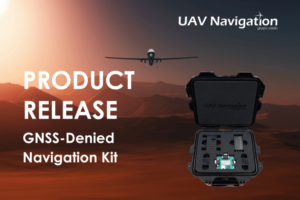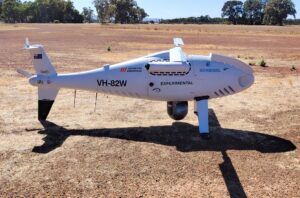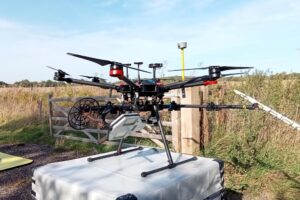Tomorrow will be a big day for the drone industry — and particularly people who use DJI or other Chinese-made drones. That’s because the U.S. House of Representatives Subcommittee on Investigations and Oversight will hold a hearing on Thursday, February 15th, to debate H.R. 2864, the “Countering CCP Drones Act.”
Representatives Elise Stefanik (R-NY) and Mike Gallagher (R-WI) introduced the controversial bill. It calls out Shenzhen Da-Jiang Innovations Sciences and Technologies Company Limited (the Chinese drone maker commonly known as DJI Technologies), specifically. The bill proposes a wide-ranging ban on drones manufactured by DJI, the world’s leading drone maker based in China. Most notably is that it would prevent new DJI products from coming to market in the United States.
The legislation would do that by adding DJI to the Federal Communications Commission’s (FCC) Covered List. That means that DJI technologies would potentially be prohibited from operating on U.S. communications infrastructure. Since drones are largely reliant on FCC networks, being prohibited from being able to operate on them effectively would make these drones unusable in the U.S. The ban on new DJI drones would stem from the fact that the FCC would no longer be able to approve new equipment authorizations for DJI products in the U.S. Read the full Countering CCP Drones Act bill text here.
This has ignited a fierce debate, raising concerns about national security, economic impact, and potential technological advancements stifled.
Security concerns fuel push for a Chinese drone ban
Proponents of the bill, primarily Republicans, have argued that DJI poses a national security threat due to its ties to the Chinese government. They cite concerns about data privacy, potential espionage, and the possibility of DJI drones being used for malicious purposes.
Anti-China sentiment in the drone industry has been going on for years no. That largely kicked off in 2017 when the U.S. Army prohibited its troops from using DJI drones. The Army memo chalked it up to cyber-security concerns. Since then, some private organizations and other government arms have suggested or implemented bans on drones made in China. At one point, the Trump administrationexplored an executive order to ban all federal departments and agencies from buying or using foreign-made drones. In late 2022, the U.S. government put DJI on a restricted trade list. Though it doesn’t ban DJI products from being sold in the U.S., it did restrict DJI from exporting US technology without a license, adding an extra layer of complication to make sales on their end. It’s also made some consumers hesitant to buy DJI drones.
The Countering CCP Drones Act was introduced in the House in April 2023.
“DJI drones pose the national security threat of TikTok, but with wings,” Stefanik said. “The possibility that DJI drones could be equipped to send live imagery of military installations, critical infrastructure, and the personal lives of American citizens to China poses too great a threat. Allowing this practice to continue in the U.S. is playing with fire. This Chinese-controlled company cannot be allowed to continue to operate in the U.S.”
How the Countering CCP Drones Act could hurt drone pilots
According to the Countering CCP Drones Act, DJI makes more than 50% of drones sold in the U.S. All sorts of people use them.
There are the recreational drone pilots who take photos with their drones — and who rely on high-quality yet affordable drones to make their hobby affordable. Small businesses that can’t afford more expensive American-made drones are reliant on DJI. Even big companies like Shell use DJI drones.
A note on Stefanik’s website even cites how DJI products comprise the most popular drones in use by public safety agencies. Because DJI drones are so easy to fly, they make for a useful tool in agencies like police departments, that otherwise are often underfunded in many cities.
Given that, the bill has faced strong opposition from the drone industry, government agencies, and individual users. Critics argue that a blanket ban on DJI products would be detrimental to the U.S. drone industry. In particular, they fear it could hinder technological advancements and innovation.
“This bill could cripple the burgeoning U.S. drone industry and force hundreds of thousands of Americans out of work, while leading to product shortages and higher prices for all,” according to a statement from the Drone Advocacy Alliance. The Drone Advocacy Alliance formed in summer 2023 as a group of drone stakeholders. Founding members included Blue Nose Aerial Imaging, Dronelink, DroneSense, the Drone Service Providers Alliance (DSPA), the Pilot Institute and the Uncrewed Trade Alliance. Though the biggest founding partner of the alliance might come as most unsurprising: DJI itself. In fact, DJI sponsors the group and maintains its website.
A boon for American-made drones?
Not every aspect of the drone industry would necessarily be hurt should the Countering CCP Drones Act pass. American drone makers would very likely thrive if people were forced to buy non-Chinese drones.
“We must ensure that the drones we use for critical operations are fully secure,” said Senator Ted Budd (R-NC). “We must invest in U.S. drone manufacturing. And we must foster a regulatory environment that promotes innovation on our shores, and it doesn’t push it overseas.”
Lawmakers have certainly proven their interest in supporting drone manufacturing. For example, Utah Sen. Mitt Romney visited Teal’s Utah factory in August 2023. That indicated a clear sign of support for the company known for making military-focused drones such as the Teal 2. Not coincidentally, Romney co-sponsored the American Security Drone Act of 2023. That bipartisan bill would prohibit federal agencies from purchasing drones made by Chinese government-linked countries.
That might not be a huge deal for businesses seeking enterprise-grade drones anyway. But for people seeking consumer drones — particularly drones that cost less than $1,000 — there’s a very real problem. There’s not a single American-made drone under $1,000 out there that The Drone Girl recommends.
What alternatives are out there?
Sure, finding a balance between national security concerns and the economic and technological implications of a ban will be crucial. So what alternative paths could be out there besides a blanket ban? Expect to hear them presented during Thursday’s hearing.
Potential compromises could include alternative solutions such as mandatory security audits for DJI drones or increased government oversight.
But either way, the outcome of tomorrow’s Countering CCP Drones Act hearing could have significant ramifications. In particular, it could impact the future of the U.S. drone industry and its relationship with China.
How to follow the Countering CCP Drones Act
The discussion around the Countering CCP Drones Act will be part of a broader legislative hearing titled “Securing American Communications Networks from Foreign Adversaries.” Foreign adversaries in this case largely mean China.
House Energy and Commerce Committee Chair Cathy McMorris Rodgers (R-WA) and Communications and Technology Subcommittee Chair Bob Latta (R-OH) will lead the meeting. The meeting will discuss not just the Countering CCP Drones Act, but also other legislation such as the Future Uses of Technology Upholding Reliable and Enhancing Networks (FUTURE) Networks Act (H.R. 1513) and the Foreign Adversary Communications Transparency Act (H.R. 820).
“As we’ve grown increasingly connected and more reliant on technology, these networks have become a target for adversaries and bad actors,” said Chairs Rodgers and Latta in a joint statement. “To remain competitive and secure, the U.S. must ensure our communications and technological infrastructure is protected against adversaries, in particular the Chinese Communist Party.”
The hearing is set for Feb. 15 at 10 a.m. ET. It is open to the public. The hearing will be held at the 2123 Rayburn House Office Building should you choose to show up to Washington, D.C. in real life. Otherwise you can stream it online here.
The post Countering CCP Drones Act hearing weighs ban on Chinese-made drones appeared first on The Drone Girl.
 Commercial drone technology is advancing rapidly, providing cost-effective and robust capabilities for a variety of civil and military missions. DARPA’s Rapid Experimental Missionized Autonomy (REMA) program aims to enable a drone to autonomously continue its predefined mission when connection to the operator is lost. The program is focused on constantly providing new agnostic drone autonomy […]
Commercial drone technology is advancing rapidly, providing cost-effective and robust capabilities for a variety of civil and military missions. DARPA’s Rapid Experimental Missionized Autonomy (REMA) program aims to enable a drone to autonomously continue its predefined mission when connection to the operator is lost. The program is focused on constantly providing new agnostic drone autonomy […] Commercial drone technology is advancing rapidly, providing cost-effective and robust capabilities for a variety of civil and military missions. DARPA’s Rapid Experimental Missionized Autonomy (REMA) program aims to enable a drone to autonomously continue its predefined mission when connection to the operator is lost. The program is focused on constantly providing new agnostic drone autonomy […]
Commercial drone technology is advancing rapidly, providing cost-effective and robust capabilities for a variety of civil and military missions. DARPA’s Rapid Experimental Missionized Autonomy (REMA) program aims to enable a drone to autonomously continue its predefined mission when connection to the operator is lost. The program is focused on constantly providing new agnostic drone autonomy […]




